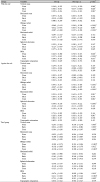Abstract
Purpose
The purpose of this study was to compare changes in higher-order aberrations after superior-incision cataract surgery between eyes with a within-the-rule (WTR) astigmatism and an against-the-rule (ATR) astigmatism in patients with positive vertical coma.
Methods
This study included patients who presented with positive vertical coma and who underwent cataract surgery through a 2.5 mm superior clear corneal incision. The eyes included in this study were divided into two groups (37 eyes with WTR astigmatism and 33 eyes with ATR astigmatism), and uncorrected visual acuity, best corrected visual acuity, and corneal astigmatism were measured before and after surgery. In addition, anterior, posterior, and total aberrations (i.e., oblique trefoil, horizontal trefoil, vertical coma, horizontal coma, spherical aberration, and total higher-order aberrations) were measured using a Pentacam.
Results
In the WTR astigmatism group, anterior/posterior corneal aberrations and total aberrations were significantly decreased after surgery (p < 0.05). However, in the ATR astigmatism group, a significant decrease in the posterior vertical coma (p = 0.008) was observed, although there was no change in total vertical coma. A significant increase in oblique trefoil was observed in both groups, while a significant decrease in horizontal trefoil was found in the ATR astigmatism group (all p < 0.05). For spherical aberration, the ATR astigmatism group showed a significant decrease in anterior cornea aberrations (p < 0.001). For total higher-order aberrations, the WTR astigmatism group showed a significant increase in anterior and posterior aberrations, while the ATR astigmatism group showed a significant increase in posterior aberrations (p < 0.05, p = 0.001, respectively). In the case of horizontal coma and corneal astigmatism, both groups exhibited no significant changes after surgery.
Figures and Tables
Figure 1
Changes of higher-order aberrations in total corneal aberrations. (A) In the with the rule astigmatism group, changes of vertical coma, oblique trefoil and HOA were statistically significant after surgery. (B) In the against the rule astigmatism group, changes of oblique and horizontal trefoil were statistically significant. Error bar represented by standard error mean. HOA = total higher-order aberrations (3rd-6th order); Pre-op = preoperative; Post-op 1 m = post-operative 1 months. *Statistically significant (p < 0.05); †Statistically significant (p < 0.001).

Figure 2
Comparison of changes in higher-order aberrations in two groups. (A-C) Change of horizontal trefoil in anterior corneal aberrations was significantly different between with the rule and against the rule astigmatism. HOA = total high order aberrations (3rd-6th order). *Statistically significant (p = 0.045).

References
1. Zhu X, Dai J, Chu R, et al. Accuracy of WASCA aberrometer refraction compared to manifest refraction in Chinese adult myopes. J Refract Surg. 2009; 25:1026–1033.
2. Applegate RA, Marsack JD, Ramos R, Sarver EJ. Interaction between aberrations to improve or reduce visual performance. J Cataract Refract Surg. 2003; 29:1487–1495.
3. Muñoz G, Albarrán-Diego C, Javaloy J, et al. Combining zonal refractive and diffractive aspheric multifocal intraocular lenses. J Refract Surg. 2012; 28:174–181.
4. Moon SJ, Lee DJ, Lee KH. Induced astigmatism and high-order aberrations after 1.8-mm, 2.2-mm and 3.0-mm coaxial phacoemulsification incisions. J Korean Ophthalmol Soc. 2011; 52:407–413.
5. Campbell CE. A new method for describing the aberrations of the eye using Zernike polynomials. Optom Vis Sci. 2003; 80:79–83.
6. Artal P, Guirao A. Contributions of the cornea and the lens to the aberrations of the human eye. Opt Lett. 1998; 23:1713–1715.
7. Williams D, Yoon GY, Porter J, et al. Visual benefit of correcting higher order aberrations of the eye. J Refract Surg. 2000; 16:S554–S559.
8. Lombardo M, Lombardo G. Wave aberration of human eyes and new descriptors of image optical quality and visual performance. J Cataract Refract Surg. 2010; 36:313–331.
9. Pantanelli S, MacRae S, Jeong TM, Yoon G. Characterizing the wave aberration in eyes with keratoconus or penetrating keratoplasty using a high-dynamic range wavefront sensor. Ophthalmology. 2007; 114:2013–2021.
10. Song IS, Kim MJ, Yoon SY, et al. Higher-order aberrations associated with better near visual acuity in eyes with aspheric monofocal IOLs. J Refract Surg. 2014; 30:442–446.
11. Nishi T, Nawa Y, Ueda T, et al. Effect of total higher-order aberrations on accommodation in pseudophakic eyes. J Cataract Refract Surg. 2006; 32:1643–1649.
12. Yao K, Tang X, Ye P. Corneal astigmatism, high order aberrations, and optical quality after cataract surgery: microincision versus small incision. J Refract Surg. 2006; 22:9 Suppl. S1079–S1082.
13. Jeong HJ, Jung BJ, Hwang HB, Kim HS. Comparison of higher order aberrations and astigmatism after on-axis small incision cataract surgery. J Korean Ophthalmol Soc. 2014; 55:182–189.
14. Can İ, Bayhan HA, Çelik H, Ceran BB. Comparison of corneal aberrations after biaxial microincision and microcoaxial cataract surgeries: a prospective study. Curr Eye Res. 2012; 37:18–24.
15. Helbostad JL, Oedegaard M, Lamb SE, et al. Change in vision, visual disability, and health after cataract surgery. Optom Vis Sci. 2013; 90:392–399.
16. Kwon HL, Park HR, Koo BS, Kim TI. Higher-order aberrations in pseudophakia with different intraocular lenses. J Korean Ophthalmol Soc. 2005; 46:954–960.
17. Guirao A, Redondo M, Geraghty E, et al. Corneal optical aberrations and retinal image quality in patients in whom monofocal intraocular lenses were implanted. Arch Ophthalmol. 2002; 120:1143–1151.
18. Ye H, Zhang K, Yang J, Lu Y. Changes of corneal higher-order aberrations after cataract surgery. Optom Vis Sci. 2014; 91:1244–1250.
19. Oshika T, Mimura T, Tanaka S, et al. Apparent accommodation and corneal wavefront aberration in pseudophakic eyes. Invest Ophthalmol Vis Sci. 2002; 43:2882–2886.
20. Choi JA, Chung SK, Kim HS. Comparative study of microcoaxial cataract surgery and conventional cataract surgery. J Korean Ophthalmol Soc. 2008; 49:904–910.




 PDF
PDF ePub
ePub Citation
Citation Print
Print





 XML Download
XML Download